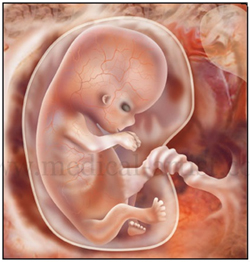|

|

Your dream child at 8th week
www.mydreamchild.com
|
 |
|
Congratulations!!!!! Now medically speaking, the embryo is now officially called a fetus (meaning young or little one), although you have probably referred to it as ‘ my baby’ from the very beginning. This week, she's growing about a milimeter each day.
|
|

|
Development

- If you could see your baby now, you'd be able to make out her eyelids, the tip of her nose, and her upper lip.
- She's approximately three-quarters of an inch long from top to bottom, and her brain, spinal cord, heart, kidneys, liver, and stomach have begun to take shape.
- The aortic and pulmonary valves are distinctly present in the heart, which has now divided into right and left chambers and gallops at twice your rate (about 150 times a minute).
- She has distinct, slightly webbed fingers and toes and see-through skin.
- The intestines are long and some of them protrude into the umbilical cord.
- The kidneys now start to produce urine for the first time.
- The pituitary gland, which is responsible for the production of hormones and growth, is developing.
|
|

|
Appearance
Your dream child is now recognizably human, with much more distinct features. Her fingers and toes are now only slightly webbed, and her tail (yes, she had one) is gone. Fun fact is your baby's taste buds are now forming. Her skin is transparent, and blood vessels are visible beneath it. The outer part of her ears is developing on the side of her neck. You can't feel it yet, but she's moving those arms and legs like crazy!
|
|

|
What is amniotic fluid?
Amniotic fluid is a clear, slightly yellowish liquid that surrounds the unborn baby (fetus) during pregnancy. It is contained in the amniotic sac.
While in the womb, the baby floats in the amniotic fluid. The amount of amniotic fluid is greatest at about 34 week into the pregnancy, when it averages 800 ml. Approximately 600 ml of amniotic fluid surrounds the baby at full term (40 weeks gestation).
The amniotic fluid constantly moves (circulates) as the baby swallows and "inhales" the fluid, and then releases it.
The amniotic fluid helps:
- The developing baby to move in the womb, which allows for proper bone growth
- The lungs to develop properly
- Keep a relatively constant temperature around the baby, protecting from heat loss
- Protect the baby from outside injury by cushioning sudden blows or movements
- Amniotic fluid is a good conductor of sound.
- Amniotic fluid contains a range of substances, for example, glucose, fructose, salt, proteins, amino acids, citric acids, urea, lactic acids and fatty acids.
Analysis of amniotic fluid, drawn out of the mother's abdomen in an amniocentesis procedure, can reveal many aspects of the baby's genetic health. This is because the fluid also contains fetal cells which can be examined for genetic defects.
|
|

|
|
My Dream Child websites and publications are for informational purposes only. If you have any concerns about your health or the health of your child, you should always consult a doctor. Information in this email is intended for visitors from India. My Dream Child is responsible for published content according to our Terms of Use and Privacy Policy.
© 2013-2014 My Dream Child.
|
|

|
|